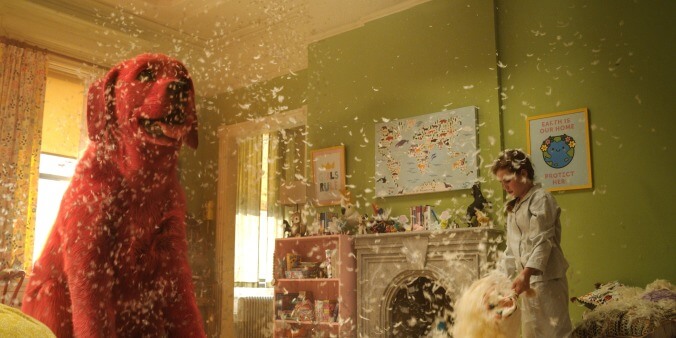Clifford The Big Red Dog gets smaller on his trip to the silver screen
Still, for pet-averse and/or apartment-dwelling parents, this might play more like a horror show

It’s comforting to know that not every bit of intellectual property becomes bombastically overblown in the transition to movie screens (or fledgling streamers, as the case may be). In nearly 200 children’s books, bright red canine Clifford appears somewhere between the size of a larger dinosaur and a medium kaiju. (Like many kaiju before him, his size is not entirely consistent).
But for his live action-ish feature debut Clifford The Big Red Dog, he’s only slightly bigger than an elephant, which is giant for a dog, enormous for a New York City apartment resident, and sure to cause stress when the time comes for his adoptive family to deal with his inevitable burial. But he’s not the house-sized terror depicted on the page. Meanwhile, his owner Emily Elizabeth (Darby Camp) goes through a familiar kid-movie upsizing: Though Clifford (not to be confused with Clifford) is plainly aimed at the under-10 crowd, Emily has been aged up to a lonely 12-year-old scholarship student at a fancy private middle school.
And some younger audience members will enjoy the aspirational rush of looking up at big kids who share their interests in cute animals and standing up to cartoonish bad guys. But it’s still bizarre to note how many children’s films feel obligated to shoehorn in subplots about mean girls and crushes—including, now, a Clifford movie that adapts kindergarten-ready picture books into a Sesame Street-like celebration of New York neighborhood diversity. Was this story really crying out for a cruel popular girl to serve as a secondary antagonist?
Clifford is more endearing when it explores the rent-controlled Harlem building where Emily lives with her single mom Maggie (Sienna Guillory), spotlighting an overly scrubbed but likable mix of elderly eccentrics, cheerful yuppies, friendly deli guys, and a cranky super. When Maggie is called away for a work trip, she’s forced to rely on her irresponsible younger brother Casey (Jack Whitehall), an aspiring illustrator who can’t make it to a job interview on time, to look after Emily. Confusingly, Whitehall and Guillory, both English, are cast as siblings. But only Guillory is allowed to keep her native accent, necessitating an explanation of how Maggie was raised partially in Britain but Casey wasn’t. Clifford may be fine sprinkling its characters with dog piss, but it’s got a strict cap on the number of minutes it will allow children to be exposed to the pernicious influence of English accents.
What follows will play like a horror story for many New York City parents: As soon as Maggie leaves town, her child is allowed to adopt a puppy through some magical rigamarole seemingly overseen by the mysterious Mr. Bridwell, played by John Cleese in a performance whose twinkle-to-wit ratio could have used a slight adjustment. When Emily first acquires the bright red Clifford, he’s tiny even by puppy standards. The next morning, however, he has somehow grown to furniture-busting size. (Again, parents are strongly cautioned: This is a very disturbing movie if you happen to live in a small apartment.)
The movie ambles along from there, with the feckless Casey, the fiercely protective Emily, and her classmate Owen (Izaac Wang) running various Clifford-related errands, crossing paths with multiple Saturday Night Live alumni, and attracting the nefarious attentions of Tieran (Tony Hale), a genetic engineer who hopes to unlock the secrets of whatever glandular disorder Clifford appears to have.
Hale was presumably called in by director Walt Becker, who previously oversaw his relentless pursuit of the Chipmunks in The Road Chip. (He also made the ill-regarded Old Dogs and Wild Hogs, suggesting a film career guided by animal names, or possibly Cockney rhyming slang.) Though Hale is, regrettably, funnier in The Road Chip, Clifford as a whole doesn’t reach rodent-level lows in its pursuit of elementary-school crowd pleasing. It’s harmless bad, not torture bad. And there’s not much sacrilege in the adaptation, given that the Clifford books are kind of inane, too.
Still, even if Clifford doesn’t inspire Paddington-level invention, personality, or basic dignity, there are hints of an approach to this material that could be sweeter, less pointlessly quippy, and less interested in hand-waving away conflict under the guise of dog-loving unity. Plenty of Clifford books take place in bland, nondescript locations with paper-thin characterizations. In relocating the story to New York, the movie ultimately only seems eager to join in on gentrification.